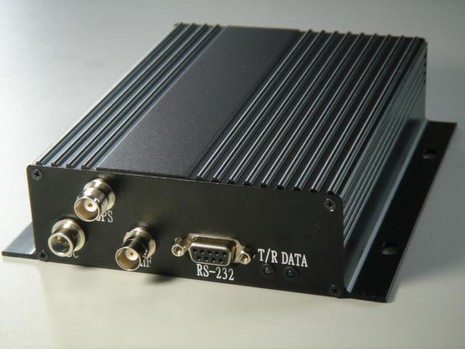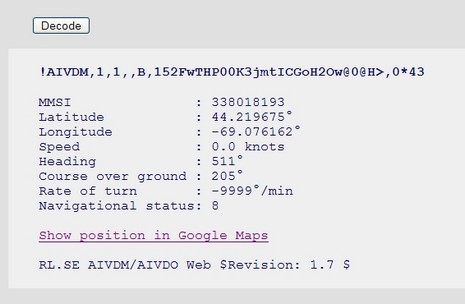Smart Radio SR261, pirate Class A AIS?

Above is the odd little Smart Radio SR261 “AIS Modem”, which claims “most of the functions of a class A ais transponder with a fraction of costs.” Let me say right up front that I absolutely do not recommend using this device, and think it may even endanger the AI system. Let me also note that the Chinese manufacturer, Smart Radio (SR), has nothing to do with similar-sounding Software Radio Technology (SRT), the British firm that builds all the circuit boards in the legitimate Class B transponders currently waiting an FCC waiver (take action!). And while Smart Radio is the manufacturer of the SR161 and 162 AIS receivers, I have heard nothing but praise for those units and particularly for the main U.S. distributor Milltech Marine.
In fact, Smart Radio is smart enough that it will not ship a SR261 transponder to the U.S. So how did I test one, however furtively in the confines of a concrete basement (with GPS antennas running out through a pipe)? Well, friends, it’s a tiny marble we live on. I recently met a sailor who happened to be passing through my neighborhood on break from an almost-around-the-marble cruise on his 30’ sloop. We got talking and—zounds!—he was lugging a SR261 in his suitcase so he could fool with programming it (not easy). He’d had a frightening near miss with a ship out in the Indian Ocean, and had met other blue water cruisers who’d bought these units online from China for about $700.
Well, I can tell you that it does work, sort of. Using an AIS receiver and Coastal Explorer, we could see the SR261 target across the basement, though we never got the vessel name or call sign we programmed into it. And another AIS program I have identified its signal as Class A. Plus a neat, but limited, online AIS message decoder further confirmed that at least its (CE-logged) AIVDM message translates into something vaguely sensible, as seen below. But, mind you, the SR261, and its SR260 sibling, aren’t like any other Class A, or B, transponders, not even close. They can supposedly act like either, at 5 watts, not 2 or 12; the user sets the time interval between dynamic message transmissions, instead of it being set according to speed and rules (!); and I think they only transmit on one channel. Plus I very much doubt that they can be controlled by shore authorities, a capability expensively built in to all approved As and Bs. What I really wonder, though, is if these SR transponders share the AIS frequencies properly with Class A and B devices that actually follow the standards? Maybe someone with more technical knowledge and/or better testing facilities can tell us.
One thing I do know is that the NMEA output of at least this particular unit seemed dicey. CE, normally excellent at NMEA 0183 parsing, wouldn’t recognize the data at all, though SeaClear II did, at least the GPS messages. Plus, the way you program the SR261 is by sending arcane codes into it using Hyperterminal, which also revealed the NMEA strings coming out of the unit. Some looked pretty funky to me. My new cruising friend says he’s seen AIS targets with this unit hooked up to MaxSea, but also that other cruisers are having a hard time getting data out of their SR261s. He’s now en route to another continent and hemisphere, with thousands of sea miles ahead of him, and I truly hope the transponder gives him great “see and be seen” service. And that he doesn’t pull into some port and have the authorities come out and confiscate it! “Pirate” may be too strong a word, but I really wonder if these Smart Radio transponders should be in use anywhere. And, sort of related, I wish that the Class B manufacturers could be making lots of U.S. sales right now and hence developing better and less expensive transponders (take action!).


 Share
Share
Did you happen to open up the box to see which chipset it uses? (They have a photo on the website but it is not clear enough to tell.) I would doubt very much that a company like SR would have the resources to build their own, they are probably just packaging something like this: http://www.cmlmicro.com/Products/innovate/docs/Inv910.pdf
The SR website claims that the unit can be controlled from the shore. I don't think that an AIS unit would even work if it couldn't be, it has to negotiate for a slot assignment with other units.
Your concerns about overall quality may be well founded (how good is the radio circuit?) but I suspect that the basic AIS functionality probably works as well as any other product that uses that chipset. It is kind of equivalent to a cheap Chinese computer with an Intel chip inside; the power supply may be crud but it will run your windows programs.